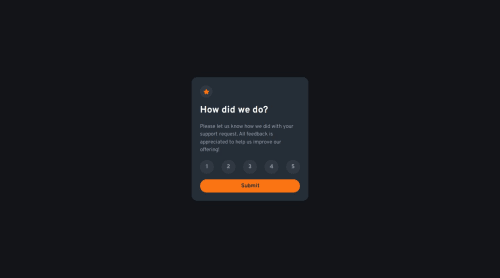Interactive rating component

Please log in to post a comment
Log in with GitHubCommunity feedback
- P@Smailen5
Great solution 😉
- @Papi84
Semantic HTML:
The use of semantic HTML is fundamental to both accessibility and SEO. After reviewing the code, I noticed that while the basic structure is in place, there could be improvements in how certain elements are tagged. For instance, instead of using adivfor the rating buttons, you could consider using afieldsetwithlegendandinputelements (such as radio buttons) to give the rating system better semantics. This would also enhance the accessibility of the component.
** Accessibility Improvements:**
A few accessibility adjustments would improve the user experience for those using assistive technologies. Addingaria-labelsoraltattributes to interactive elements can make sure screen readers convey the purpose of those elements. For example, labeling the rating buttons with more descriptive text or usingaria-pressedto indicate the state of the rating selection would improve usability. Ensure that the focus state is visually distinct for keyboard navigation, and make sure the form can be submitted via the keyboard.
** Responsive Design:**
The layout seems to work well on most screen sizes, but I noticed some room for improvement. On smaller screens, the content can become cramped. Consider usingflexboxorgridwith more media queries to ensure the component remains well-spaced and visually balanced on all screen sizes. It might help to add more spacing and adjust font sizes for smaller devices.
** Code Structure and Readability:**
The code is generally clean and readable, but there are a few areas where it could be more efficient. You could break down repeated styles in the CSS into reusable classes to avoid redundancy. Additionally, ensuring consistent indentation and adding comments for sections of the code would enhance readability, especially for collaborators or future updates.
** Alignment with Design:**
The solution closely follows the design in terms of structure and functionality. However, one area for improvement would be ensuring that the visual details—such as margins, paddings, and font sizes—match the design more precisely. This attention to detail can elevate the final product and make it feel more polished. Overall:
Great effort on completing the project! The functionality works as expected, and with a few adjustments to semantic HTML, accessibility, and responsiveness, this project could really stand out. Keep up the good work, and refining these aspects will bring your skills to the next level.
Join our Discord community
Join thousands of Frontend Mentor community members taking the challenges, sharing resources, helping each other, and chatting about all things front-end!
Join our Discord